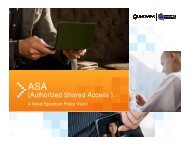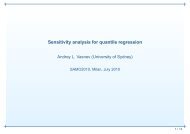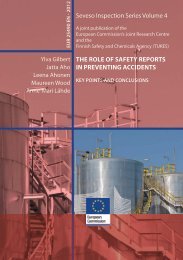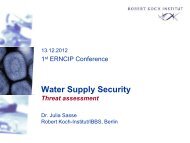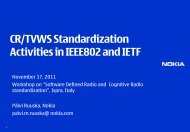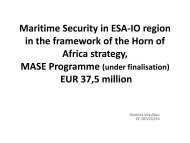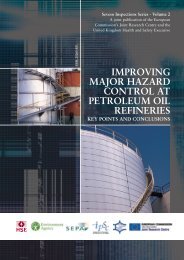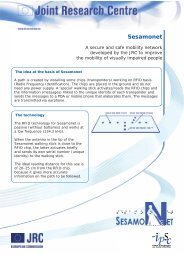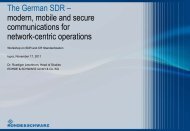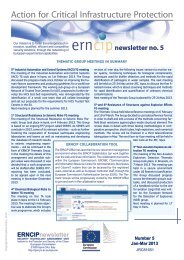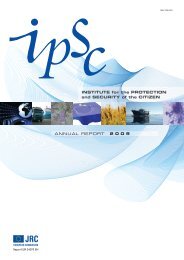Guidelines on a Major Accident Prevention Policy and Safety ... - IPSC
Guidelines on a Major Accident Prevention Policy and Safety ... - IPSC
Guidelines on a Major Accident Prevention Policy and Safety ... - IPSC
Create successful ePaper yourself
Turn your PDF publications into a flip-book with our unique Google optimized e-Paper software.
INSTITUTE FOR SYSTEMS INFORMATICS AND SAFETY<br />
<str<strong>on</strong>g>Guidelines</str<strong>on</strong>g> <strong>on</strong> a <strong>Major</strong> <strong>Accident</strong> Preventi<strong>on</strong> <strong>Policy</strong><br />
<strong>and</strong> <strong>Safety</strong> Management System,<br />
as required by Council Directive 96/82/EC (SEVESO II)<br />
Neil Mitchis<strong>on</strong> & Sam Porter (Eds.)<br />
ISBN 92-828-4664-4 EUR 18123 EN
Table of C<strong>on</strong>tents<br />
Acknowledgements<br />
Preface<br />
1 Introducti<strong>on</strong> to <strong>Safety</strong> Management Systems<br />
2 Development of a <strong>Major</strong> <strong>Accident</strong> Preventi<strong>on</strong> <strong>Policy</strong> (MAPP)<br />
3 Elements of <strong>Safety</strong> Management Systems<br />
Organisati<strong>on</strong> <strong>and</strong> pers<strong>on</strong>nel<br />
Hazard identificati<strong>on</strong> <strong>and</strong> evaluati<strong>on</strong><br />
Operati<strong>on</strong>al c<strong>on</strong>trol<br />
Management of change<br />
Planning for emergencies<br />
M<strong>on</strong>itoring performance<br />
Audit <strong>and</strong> review<br />
4 Bibliography
Acknowledgements<br />
These guidelines have been developed in close collaborati<strong>on</strong> with a Technical Working Group (“TWG4”) appointed for the<br />
purpose by DG XI of the European Commissi<strong>on</strong>, <strong>and</strong> have been endorsed by the Committee of Competent Authorities for the<br />
Implementati<strong>on</strong> of the “Seveso” Directives. The editors would like to thank all the members of TWG4 (<strong>and</strong> their various<br />
colleagues) for their c<strong>on</strong>structive comments <strong>and</strong> suggesti<strong>on</strong>s throughout the process of drawing up <strong>and</strong> testing this document.<br />
The help of Stelios Loupasis, MAHB, in assembling the bibliography is also gratefully acknowledged.<br />
Members of TWG4 <strong>and</strong> invited experts in additi<strong>on</strong> to the editors (in alphabetical order)<br />
ANIELLO AMENDOLA MAHB, JRC, European Commissi<strong>on</strong><br />
TERJE AUSTERHEIM Directorate of Fire <strong>and</strong> Explosi<strong>on</strong> Preventi<strong>on</strong>, Norway<br />
PETER BENTLEY<br />
Shell Internati<strong>on</strong>al, The Netherl<strong>and</strong>s<br />
MAGNUS BLOMQUIST Nati<strong>on</strong>al Board of Occupati<strong>on</strong>al <strong>Safety</strong> <strong>and</strong> Health, Sweden<br />
WILLIËT BROUWER Ministerie van Sociale Zaken en Werkgelegenheid, the Netherl<strong>and</strong>s<br />
NORMAN BYROM<br />
Health <strong>and</strong> <strong>Safety</strong> Executive, UK<br />
CARLO CACCIABUE JRC, European Commissi<strong>on</strong><br />
RITA CAROSELLI<br />
Ministero dell’Ambiente, Italy<br />
COLETTE CLEMENTÉ Ministère de l’Envir<strong>on</strong>nement, France<br />
RON DE CORT<br />
Health & <strong>Safety</strong> Executive, UK<br />
RAFFAELE DELLE PIANE ISPESL, Italy<br />
BERND FRÖHLICH Exx<strong>on</strong> Chemical Internati<strong>on</strong>al, Germany<br />
VÉRONIQUE GAZDA Ministère de l’Envir<strong>on</strong>nement, France<br />
JAN GINCKELS<br />
AIB - Vincotte Inter, Belgium<br />
JACOB JESSEN<br />
The Associati<strong>on</strong> of Danish Chemical Industries, Denmark<br />
E.F.J. KOK<br />
Moret Ernst & Young, The Netherl<strong>and</strong>s<br />
W.J. KOLK<br />
DuP<strong>on</strong>t de Nemours, The Netherl<strong>and</strong>s<br />
HARALD LORENZ<br />
Hessiches Ministerium für Umwelt, Germany<br />
G. MARSILI Istituto Superiore di Sanità, Italy<br />
DAVID MILNE<br />
Shell Internati<strong>on</strong>al, The Netherl<strong>and</strong>s<br />
GEORGE MOUZAKIS Ministry of the Envir<strong>on</strong>ment, Greece<br />
KEVIN MYERS<br />
DG XI, European Commissi<strong>on</strong><br />
HANS-JÜRGEN PETTELKAU Bundesministerium für Umwelt, Germany<br />
SEBASTIANO SERRA Ministero dell’Ambiente, Italy<br />
RUI FIGUEIREDO SIMÕES ATRIG, Direcçao-Geral do Ambiente, Portugal<br />
GERALD SPINDLER Georg-August-Universität Göttingen, Germany<br />
JEAN-PAUL TRESPAILLÉ Associati<strong>on</strong> Européenne des Gaz de Pétrole Liquéfiés, France<br />
JACQUES VAN STEEN TNO, The Netherl<strong>and</strong>s<br />
G. VAN DEN LANGENBERGH BASF, Belgium<br />
ERIK VAN GILS<br />
Ministry of Labour, Belgium
Preface<br />
Council Directive 96/82/EC (SEVESO II) is aimed at the preventi<strong>on</strong> of major accidents involving dangerous substances, <strong>and</strong><br />
the limitati<strong>on</strong> of their c<strong>on</strong>sequences. The provisi<strong>on</strong>s c<strong>on</strong>tained within the Directive were developed following a fundamental<br />
review of the implementati<strong>on</strong> of Council Directive 82/501/EEC (SEVESO I).<br />
In particular, certain areas were identified where new provisi<strong>on</strong>s seemed necessary <strong>on</strong> the basis of an analysis of major<br />
accidents which have been reported to the Commissi<strong>on</strong> since the implementati<strong>on</strong> of SEVESO I. One such area is management<br />
policies <strong>and</strong> systems. Failures of the management system were shown to have c<strong>on</strong>tributed to the cause of over 85 per cent of<br />
the accidents reported.<br />
Against this background, requirements for management policies <strong>and</strong> systems are c<strong>on</strong>tained in the SEVESO II Directive. The<br />
Directive sets out basic principles <strong>and</strong> requirements for policies <strong>and</strong> management systems, suitable for the preventi<strong>on</strong>, c<strong>on</strong>trol<br />
<strong>and</strong> mitigati<strong>on</strong> of major accident hazards.<br />
The Directive sets out two levels of requirements corresp<strong>on</strong>ding to ‘lower tier’ <strong>and</strong> ‘upper tier’ establishments. There is a<br />
requirement for lower tier establishments to draw up a <strong>Major</strong> <strong>Accident</strong> Preventi<strong>on</strong> <strong>Policy</strong> (MAPP), designed to guarantee a<br />
high level of protecti<strong>on</strong> for man <strong>and</strong> the envir<strong>on</strong>ment by appropriate means including appropriate management systems, taking<br />
account of the principles c<strong>on</strong>tained in Annex III of the Directive. The operator of an upper tier establishment (covered by<br />
Article 9 of the Directive <strong>and</strong> corresp<strong>on</strong>ding to a larger inventory of hazardous substances) is required to dem<strong>on</strong>strate in the<br />
‘safety report’ that a MAPP <strong>and</strong> a <strong>Safety</strong> Management System (SMS) for implementing it have been put into effect in<br />
accordance with the informati<strong>on</strong> set out in Annex III of the Directive.<br />
In effect, the requirements for policies <strong>and</strong> management systems which apply to a lower tier establishment are similar to those<br />
for an upper tier establishment except that:<br />
• the Directive states that the requirements should be proporti<strong>on</strong>ate to the major-accident hazards presented by the<br />
establishment, which is c<strong>on</strong>sidered to introduce more flexibility;<br />
• it is not necessary to prepare a detailed report for dem<strong>on</strong>strating how the <strong>Safety</strong> Management System has been put into<br />
effect;<br />
• the document setting out the MAPP must be ‘made available’ but need not necessarily be sent to the competent<br />
authorities.<br />
The particular circumstances of a given establishment will mean that in many cases some of the measures proposed here will<br />
be required in more or less detail as appropriate. In the document which follows, the term “where appropriate” is used for the<br />
most significant of these cases, but should be understood to apply implicitly throughout. In certain cases, there may be aspects<br />
specific to the establishment which require the c<strong>on</strong>siderati<strong>on</strong> of particular points not set out here.<br />
This document has been produced to provide guidance <strong>and</strong> explanati<strong>on</strong> <strong>on</strong> what is required <strong>on</strong> a '<strong>Major</strong> <strong>Accident</strong> Preventi<strong>on</strong><br />
<strong>Policy</strong>' <strong>and</strong> ‘<strong>Safety</strong> Management Systems’ by the Directive. It should not be c<strong>on</strong>sidered m<strong>and</strong>atory as such <strong>and</strong> does not<br />
preclude other reas<strong>on</strong>able interpretati<strong>on</strong>s of the requirements of the Directive. It should be emphasised that this ‘guidance’ is<br />
not legislati<strong>on</strong>. However the document does give an authoritative interpretati<strong>on</strong> of the meaning of the Directive, developed by<br />
the European Commissi<strong>on</strong> through dialogue with representatives from the Member States.
1 Introducti<strong>on</strong> to <strong>Safety</strong> Management Systems<br />
Relevant text from the Directive:<br />
The safety management system should include the part of the general management system which includes the organizati<strong>on</strong>al<br />
structure, resp<strong>on</strong>sibilities, practices, procedures, processes <strong>and</strong> resources for determining <strong>and</strong> implementing the major<br />
accident preventi<strong>on</strong> policy.<br />
It is recognised that the safe functi<strong>on</strong>ing of an establishment depends <strong>on</strong> its overall management. Within this overall<br />
management system, the safe operati<strong>on</strong> of an establishment requires the implementati<strong>on</strong> of a system of structures,<br />
resp<strong>on</strong>sibilities, <strong>and</strong> procedures, with the appropriate resources <strong>and</strong> technological soluti<strong>on</strong>s available. This system is known as<br />
the <strong>Safety</strong> Management System (SMS).<br />
Thus any <strong>Safety</strong> Management System is a c<strong>on</strong>stituent part of the overall management system of the establishment, which may<br />
in turn be dependent <strong>on</strong> a management system developed for a larger entity such as a company or group of companies. This is<br />
particularly important when it comes to detailed implementati<strong>on</strong> of the guidelines set out here; the approach to<br />
implementati<strong>on</strong> will <strong>and</strong> should differ from company to company, reflecting the overall management philosophy, system, <strong>and</strong><br />
culture as appropriate for the workforce <strong>and</strong> the process technologies involved.<br />
The <strong>Safety</strong> Management System may also involve integrati<strong>on</strong> with a management system which addresses other matters, such<br />
as the health of workers, the envir<strong>on</strong>ment, quality, etc. It is possible to develop a <strong>Safety</strong> Management System by extending the<br />
scope of an existing management system, but it will be incumbent up<strong>on</strong> the operator to ensure, <strong>and</strong> dem<strong>on</strong>strate where<br />
necessary, that the management system has been fully developed to cover major-accident c<strong>on</strong>trols <strong>and</strong> meets the requirements<br />
of the Directive.<br />
A further issue in the management system c<strong>on</strong>cerns the questi<strong>on</strong> “what is management?” While there are different<br />
terminologies <strong>and</strong> detailed definiti<strong>on</strong>s, it is accepted now that management of any sizeable activity is based <strong>on</strong> the idea of a<br />
“management loop”, which involves agreeing an objective, defining a plan to achieve that objective, formulating the detailed<br />
work required to implement the plan, carrying out the work, checking the outcome against the plan, <strong>and</strong> planning <strong>and</strong> taking<br />
appropriate corrective acti<strong>on</strong>. <strong>Safety</strong> management is no excepti<strong>on</strong> to this general principle. This means that in additi<strong>on</strong> to the<br />
goals of the <strong>Safety</strong> Management System, <strong>and</strong> the issues it addresses, the integrity of the management loop <strong>and</strong> the<br />
completeness <strong>and</strong> accurate functi<strong>on</strong>ing of the management system are essential.<br />
These guidelines describe seven fundamental elements that should be included in the <strong>Safety</strong> Management System, as specified<br />
in Annex III of the Directive. They do not describe a complete <strong>Safety</strong> Management System, since such a system will cover<br />
aspects of safety other than major accident hazards, <strong>and</strong> will have to reflect the culture <strong>and</strong> structure of a specific company. It<br />
is the resp<strong>on</strong>sibility of the operator to ensure that all seven elements are incorporated into the system, including m<strong>on</strong>itoring,<br />
audit <strong>and</strong> review processes which are essential comp<strong>on</strong>ents of the system. The relevant secti<strong>on</strong>s of this document give advice<br />
<strong>on</strong> the need for sufficient independence from the operati<strong>on</strong>al unit for pers<strong>on</strong>s undertaking auditing <strong>and</strong> reviews. However it is<br />
still under the resp<strong>on</strong>sibility of the operator to ensure that independent audits <strong>and</strong> reviews are carried out.<br />
Inspecti<strong>on</strong>s carried out by, or <strong>on</strong> behalf of, the competent authorities in pursuance of Article 18 of the Directive do not replace<br />
the operator’s own resp<strong>on</strong>sibilities to ensure that the necessary m<strong>on</strong>itoring, auditing <strong>and</strong> review of the management system is<br />
carried out. However the results of operator audits <strong>and</strong> reviews may well be of interest to the inspecti<strong>on</strong> authorities.
2 Development of a <strong>Major</strong> <strong>Accident</strong> Preventi<strong>on</strong><br />
<strong>Policy</strong> (MAPP)<br />
Relevant text from the Directive:<br />
The major accident preventi<strong>on</strong> policy should be established in writing <strong>and</strong> should include the operator’s overall aims <strong>and</strong><br />
principles of acti<strong>on</strong> with respect to the c<strong>on</strong>trol of major accident hazards.<br />
The operator must draw up a document setting out his <strong>Major</strong>-<strong>Accident</strong> Preventi<strong>on</strong> <strong>Policy</strong> (MAPP). The document is intended<br />
to give an overview of how the operator ensures a high level of protecti<strong>on</strong> for man <strong>and</strong> the envir<strong>on</strong>ment. The document should<br />
take account of the principles c<strong>on</strong>tained in Annex III of the SEVESO II Directive in the following seven areas:<br />
• organizati<strong>on</strong> <strong>and</strong> pers<strong>on</strong>nel<br />
• identificati<strong>on</strong> <strong>and</strong> evaluati<strong>on</strong> of major hazards<br />
• operati<strong>on</strong>al c<strong>on</strong>trol<br />
• management of change<br />
• planning for emergencies<br />
• m<strong>on</strong>itoring performance<br />
• audit <strong>and</strong> review<br />
The text given in the subsequent secti<strong>on</strong>s of this guidance document is intended to describe the above elements within a<br />
<strong>Safety</strong> Management System but can also be used as a guide to the meaning of each of the elements within the MAPP.<br />
The MAPP can be a much less detailed document than <strong>on</strong>e which describes the <strong>Safety</strong> Management System but should clearly<br />
indicate the arrangements, structures <strong>and</strong> management systems required for each of the seven areas.<br />
A MAPP is not a mini safety report <strong>and</strong> should refer to other detailed documentati<strong>on</strong> where necessary. Indeed there will<br />
normally be a hierarchy of documentati<strong>on</strong>: at the top of this hierarchy the MAPP sets out the policy <strong>and</strong> principles of major<br />
hazard preventi<strong>on</strong>, <strong>and</strong> then each subsequent level explains in more detail the applicati<strong>on</strong> of these principles, finishing with<br />
working documents <strong>and</strong> instructi<strong>on</strong>s.<br />
The scope of applicati<strong>on</strong> of the MAPP should be clearly stated <strong>and</strong> should be c<strong>on</strong>sistent with covering all sources of majoraccident<br />
hazards.<br />
Operators may already have a formal statement of safety policy in some form, possibly integrated with statements of policy<br />
covering health <strong>and</strong> envir<strong>on</strong>mental protecti<strong>on</strong> issues. In such cases, the operator may wish to review an existing policy<br />
document <strong>and</strong> revise it as necessary to include the requirements of a MAPP as specified by the Directive. It may also be<br />
appropriate in some cases to prepare the MAPP as an addendum to existing policy documents.
3 Elements of <strong>Safety</strong> Management Systems<br />
Organisati<strong>on</strong> <strong>and</strong> pers<strong>on</strong>nel<br />
Relevant text from the Directive:<br />
The following issues shall be addressed by the safety management system:<br />
Organisati<strong>on</strong> <strong>and</strong> pers<strong>on</strong>nel - the roles <strong>and</strong> resp<strong>on</strong>sibilities of pers<strong>on</strong>nel involved in the management of major hazards at all<br />
levels in the organisati<strong>on</strong>. The identificati<strong>on</strong> of training needs of such pers<strong>on</strong>nel <strong>and</strong> the provisi<strong>on</strong> of the training so<br />
identified. The involvement of employees <strong>and</strong>, where appropriate, sub-c<strong>on</strong>tractors.<br />
The <strong>Safety</strong> Management System should reflect the top-down commitment <strong>and</strong> the safety culture of the operator’s organisati<strong>on</strong>,<br />
translated into the necessary resources <strong>and</strong> direct resp<strong>on</strong>sibilities of pers<strong>on</strong>nel involved in the management of major hazards<br />
at all levels in the organisati<strong>on</strong>. The operator should identify the skills <strong>and</strong> abilities needed by such pers<strong>on</strong>nel, <strong>and</strong> ensure their<br />
provisi<strong>on</strong>.<br />
The role, resp<strong>on</strong>sibility, accountability, authority <strong>and</strong> interrelati<strong>on</strong> of all pers<strong>on</strong>nel who manage, perform or verify work<br />
affecting safety should be defined, particularly for staff resp<strong>on</strong>sible for:<br />
• the provisi<strong>on</strong> of resources, including human resources, for SMS development <strong>and</strong> implementati<strong>on</strong>;<br />
• acti<strong>on</strong> to ensure staff awareness of hazards, <strong>and</strong> compliance with the operator's safety policy;<br />
• identificati<strong>on</strong>, recording <strong>and</strong> follow-up of corrective or improvement acti<strong>on</strong>s;<br />
• c<strong>on</strong>trol of abnormal situati<strong>on</strong>s, including emergencies;<br />
• identifying training needs, provisi<strong>on</strong> of training, <strong>and</strong> evaluati<strong>on</strong> of its effectiveness;<br />
• coordinating the implementati<strong>on</strong> of the system <strong>and</strong> reporting to top management.<br />
The operator should ensure the involvement of employees, <strong>and</strong> where appropriate of c<strong>on</strong>tractors or others present at the<br />
establishment, both in determining the safety policy <strong>and</strong> in its implementati<strong>on</strong>. In particular the operator should ensure that<br />
c<strong>on</strong>tractors receive the necessary informati<strong>on</strong> <strong>and</strong> training to enable them to be aware of the hazards involved, <strong>and</strong> to satisfy<br />
the safety policy.<br />
Hazard identificati<strong>on</strong> <strong>and</strong> evaluati<strong>on</strong><br />
Relevant text from the Directive:<br />
The following issues shall be addressed by the safety management system:<br />
Identificati<strong>on</strong> <strong>and</strong> evaluati<strong>on</strong> of major hazards - adopti<strong>on</strong> <strong>and</strong> implementati<strong>on</strong> of procedures for systematically identifying<br />
major hazards arising from normal <strong>and</strong> abnormal operati<strong>on</strong> <strong>and</strong> the assessment of their likelihood <strong>and</strong> severity.<br />
The operator should develop <strong>and</strong> implement procedures to systematically identify <strong>and</strong> evaluate hazards arising from its<br />
activities, <strong>and</strong> from the substances <strong>and</strong> materials h<strong>and</strong>led or produced in them. The procedures used for the identificati<strong>on</strong> <strong>and</strong><br />
evaluati<strong>on</strong> of hazards should be formal, systematic, <strong>and</strong> critical. There should also be systematic procedures for the definiti<strong>on</strong><br />
of measures both for the preventi<strong>on</strong> of incidents <strong>and</strong> for the mitigati<strong>on</strong> of their c<strong>on</strong>sequences.
The detailed c<strong>on</strong>tent of procedures for hazard identificati<strong>on</strong> <strong>and</strong> evaluati<strong>on</strong> is bey<strong>on</strong>d the scope of this particular guidance<br />
document. However the ‘management system’ should include an assessment of the skills <strong>and</strong> knowledge required, including<br />
where appropriate a team approach in order to find the necessary combinati<strong>on</strong> <strong>and</strong> range of theoretical <strong>and</strong> practical<br />
knowledge to develop <strong>and</strong> implement appropriate procedures.<br />
Hazard identificati<strong>on</strong> <strong>and</strong> evaluati<strong>on</strong> procedures should be applied to all relevant stages from project c<strong>on</strong>cepti<strong>on</strong> through to<br />
decommissi<strong>on</strong>ing, including:<br />
• potential hazards arising from or identified in the course of planning, design, engineering, c<strong>on</strong>structi<strong>on</strong>, commissi<strong>on</strong>ing, <strong>and</strong><br />
development activities;<br />
• the normal range of process operating c<strong>on</strong>diti<strong>on</strong>s, hazards of routine operati<strong>on</strong>s <strong>and</strong> of n<strong>on</strong>-routine situati<strong>on</strong>s, in particular<br />
start-up, maintenance, <strong>and</strong> shut-down;<br />
• incidents <strong>and</strong> possible emergencies, including those arising from comp<strong>on</strong>ent or material failures, external events, <strong>and</strong><br />
human factors, including failures in the SMS itself;<br />
• hazards of decommissi<strong>on</strong>ing, ab<strong>and</strong><strong>on</strong>ment, <strong>and</strong> disposal;<br />
• potential hazards from former activities;<br />
• external hazards including those arising from natural hazards (including abnormal temperatures, fire, flood, earthquake,<br />
str<strong>on</strong>g winds, tidal waves), from transport operati<strong>on</strong>s including loading <strong>and</strong> unloading, from neighbouring activities, <strong>and</strong> from<br />
malevolent or unauthorised acti<strong>on</strong>.<br />
Due c<strong>on</strong>siderati<strong>on</strong> should be given to any less<strong>on</strong>s learnt from previous incidents <strong>and</strong> accidents (both within <strong>and</strong> outside the<br />
organisati<strong>on</strong> c<strong>on</strong>cerned), from operating experience of the installati<strong>on</strong> c<strong>on</strong>cerned or similar <strong>on</strong>es, <strong>and</strong> from previous safety<br />
inspecti<strong>on</strong>s <strong>and</strong> audits.<br />
Operati<strong>on</strong>al c<strong>on</strong>trol<br />
Relevant text from the Directive:<br />
The following issues shall be addressed by the safety management system:<br />
Operati<strong>on</strong>al c<strong>on</strong>trol - adopti<strong>on</strong> <strong>and</strong> implementati<strong>on</strong> of procedures <strong>and</strong> instructi<strong>on</strong>s for safe operati<strong>on</strong>, including maintenance,<br />
of plant, processes, equipment <strong>and</strong> temporary stoppages.<br />
The operator should prepare <strong>and</strong> keep up to date <strong>and</strong> readily available the informati<strong>on</strong> <strong>on</strong> process hazards <strong>and</strong> design <strong>and</strong><br />
operati<strong>on</strong>al limits <strong>and</strong> c<strong>on</strong>trols coming from the hazard identificati<strong>on</strong> <strong>and</strong> risk evaluati<strong>on</strong> procedures. Based <strong>on</strong> these,<br />
documented procedures should be prepared <strong>and</strong> implemented to ensure safe design <strong>and</strong> operati<strong>on</strong> of plant, processes,<br />
equipment <strong>and</strong> storage facilities. In particular, these procedures should cover:<br />
• commissi<strong>on</strong>ing<br />
• start-up <strong>and</strong> normal periodic shutdown<br />
• all phases of normal operati<strong>on</strong>s, including test, maintenance <strong>and</strong> inspecti<strong>on</strong><br />
• detecti<strong>on</strong> of <strong>and</strong> resp<strong>on</strong>se to departures from normal operating c<strong>on</strong>diti<strong>on</strong>s<br />
• temporary or special operati<strong>on</strong>s<br />
• operati<strong>on</strong> under maintenance c<strong>on</strong>diti<strong>on</strong>s<br />
• emergency operati<strong>on</strong>s<br />
• decommissi<strong>on</strong>ing.<br />
Safe working practices should be defined for all activities relevant for operati<strong>on</strong>al safety.
Procedures, instructi<strong>on</strong>s <strong>and</strong> methods of work should be developed in co-operati<strong>on</strong> with the people who are required to follow<br />
them, <strong>and</strong> should be expressed in a form underst<strong>and</strong>able to them. The operator should ensure these procedures are<br />
implemented <strong>and</strong> provide the training necessary.<br />
These written procedures should be made available to all staff resp<strong>on</strong>sible directly or indirectly for operati<strong>on</strong>, <strong>and</strong> where<br />
appropriate to others involved such as maintenance staff. They should also be subject to periodic review both to ensure that<br />
they are current <strong>and</strong> accurate, <strong>and</strong> to ensure that they are actually followed.<br />
Management of change<br />
Relevant text from the Directive:<br />
The following issues shall be addressed by the safety management system:<br />
Management of change - adopti<strong>on</strong> <strong>and</strong> implementati<strong>on</strong> of procedures for planning modificati<strong>on</strong>s to, or the design of new<br />
installati<strong>on</strong>s, processes or storage facilities.<br />
The operator should adopt <strong>and</strong> implement management procedures for planning <strong>and</strong> c<strong>on</strong>trolling all changes in people, plant,<br />
processes <strong>and</strong> process variables, materials, equipment, procedures, software, design or external circumstances which are<br />
capable of affecting the c<strong>on</strong>trol of major accident hazards. This approach should cover permanent, temporary <strong>and</strong> urgent<br />
operati<strong>on</strong>al changes, <strong>and</strong> should address:<br />
• definiti<strong>on</strong> of what c<strong>on</strong>stitutes a change<br />
• assignment of resp<strong>on</strong>sibilities <strong>and</strong> authorities for initiating change<br />
• identificati<strong>on</strong> <strong>and</strong> documentati<strong>on</strong> of the change proposed <strong>and</strong> of its implementati<strong>on</strong>;<br />
• identificati<strong>on</strong> <strong>and</strong> analysis where appropriate of any safety implicati<strong>on</strong>s of the change proposed;<br />
• definiti<strong>on</strong>, explanati<strong>on</strong> where appropriate, documentati<strong>on</strong>, <strong>and</strong> implementati<strong>on</strong> of the safety measures deemed appropriate,<br />
including informati<strong>on</strong> <strong>and</strong> training requirements, as well as the necessary changes to operati<strong>on</strong>al procedures;<br />
• definiti<strong>on</strong> <strong>and</strong> implementati<strong>on</strong> of appropriate post-change review procedures <strong>and</strong> corrective mechanisms, <strong>and</strong> subsequent<br />
m<strong>on</strong>itoring.<br />
Management of change procedures must also be applied during the design <strong>and</strong> c<strong>on</strong>structi<strong>on</strong> of new installati<strong>on</strong>s, processes,<br />
<strong>and</strong> storage facilities.<br />
Planning for emergencies<br />
Relevant text from the Directive:<br />
The following issues shall be addressed by the safety management system:<br />
Planning for emergencies - adopti<strong>on</strong> <strong>and</strong> implementati<strong>on</strong> of procedures to identify foreseeable emergencies by systematic<br />
analysis <strong>and</strong> to prepare, test <strong>and</strong> review emergency plans to resp<strong>on</strong>d to such emergencies.<br />
The detailed c<strong>on</strong>tent of the emergency plan is not within the scope of this particular guidance document. (Details of data <strong>and</strong><br />
informati<strong>on</strong> to be included in an Emergency Plan are specified in Annex IV of the Directive.) However the <strong>Safety</strong><br />
Management System does include the procedures necessary to ensure that an adequate emergency plan is developed, adopted,<br />
implemented, reviewed, tested, <strong>and</strong> where necessary revised <strong>and</strong> updated. These procedures will define the skills <strong>and</strong> abilities
equired, including where appropriate a team approach in order to find the necessary combinati<strong>on</strong> of theoretical <strong>and</strong> practical<br />
knowledge.The operator should develop <strong>and</strong> maintain procedures to identify, by systematic analysis starting from the hazard<br />
identificati<strong>on</strong> process, foreseeable emergencies arising from or in c<strong>on</strong>necti<strong>on</strong> with its activities, <strong>and</strong> to record <strong>and</strong> keep up to<br />
date the results of this analysis. Plans to resp<strong>on</strong>d to such potential emergencies should be prepared, <strong>and</strong> arrangements for<br />
testing <strong>and</strong> review <strong>on</strong> a regular basis should be included within the <strong>Safety</strong> Management System. The procedures should also<br />
cover the necessary arrangements for communicati<strong>on</strong> of the plans to all those likely to be affected by an emergency.<br />
M<strong>on</strong>itoring performance<br />
Relevant text from the Directive:<br />
The following issues shall be addressed by the safety management system:<br />
M<strong>on</strong>itoring performance - adopti<strong>on</strong> <strong>and</strong> implementati<strong>on</strong> of procedures for the <strong>on</strong>going assessment of compliance with the<br />
objectives set by the operator’s major accident preventi<strong>on</strong> policy <strong>and</strong> safety management system, <strong>and</strong> the mechanisms for<br />
investigati<strong>on</strong> <strong>and</strong> taking corrective acti<strong>on</strong> in case of n<strong>on</strong>-compliance. The procedures should cover the operator’s system for<br />
reporting major accidents or near misses, particularly those involving failure of protective measures, <strong>and</strong> their investigati<strong>on</strong><br />
<strong>and</strong> follow-up <strong>on</strong> the basis of less<strong>on</strong>s learnt.<br />
The operator should maintain procedures to ensure that safety performance can be m<strong>on</strong>itored <strong>and</strong> compared with the safety<br />
objectives defined. This should include determining whether plans <strong>and</strong> objectives are being achieved, <strong>and</strong> whether<br />
arrangements to c<strong>on</strong>trol risks are being implemented before an incident or accident occurs (active m<strong>on</strong>itoring), as well as the<br />
reporting <strong>and</strong> investigati<strong>on</strong> of failures which have resulted in incidents or accidents (reactive m<strong>on</strong>itoring).<br />
Active m<strong>on</strong>itoring should include inspecti<strong>on</strong>s of safety critical plant, equipment <strong>and</strong> instrumentati<strong>on</strong> as well as assessment of<br />
compliance with training, instructi<strong>on</strong>s <strong>and</strong> safe working practices.<br />
Reactive m<strong>on</strong>itoring requires an effective system for reporting incidents <strong>and</strong> accidents <strong>and</strong> an investigati<strong>on</strong> system which<br />
identifies not <strong>on</strong>ly the immediate causes but also any underlying failures which led to the event. It should pay particular<br />
attenti<strong>on</strong> to cases of failure of protective measures (including operati<strong>on</strong>al <strong>and</strong> management failures), <strong>and</strong> should include<br />
investigati<strong>on</strong>, analysis, <strong>and</strong> follow-up (including transfer of informati<strong>on</strong> to pers<strong>on</strong>nel involved) to ensure that the less<strong>on</strong>s<br />
learnt are applied to future operati<strong>on</strong>.<br />
The operator should define the resp<strong>on</strong>sibility for initiating investigati<strong>on</strong> <strong>and</strong> corrective acti<strong>on</strong> in the event of n<strong>on</strong>-compliance<br />
with any part of the SMS. This should include in particular revisi<strong>on</strong> where necessary of procedures or systems to prevent<br />
recurrence. The informati<strong>on</strong> from performance m<strong>on</strong>itoring should also be a significant input to the processes of audit <strong>and</strong><br />
review (see below).<br />
Audit <strong>and</strong> review<br />
Relevant text from the Directive:<br />
The following issues shall be addressed by the safety management system:<br />
Audit <strong>and</strong> review - adopti<strong>on</strong> <strong>and</strong> implementati<strong>on</strong> of procedures for periodic systematic assessment of the major accident<br />
preventi<strong>on</strong> policy <strong>and</strong> the effectiveness <strong>and</strong> suitability of the safety management system; the documented review of<br />
performance of the policy <strong>and</strong> safety management system <strong>and</strong> its up-dating by senior management.
The terms “audit” <strong>and</strong> “review” are used here for two different activities. An audit is intended to ensure that the organisati<strong>on</strong>,<br />
processes, <strong>and</strong> procedures as defined <strong>and</strong> as actually carried out are c<strong>on</strong>sistent with the <strong>Safety</strong> Management System; it should<br />
be carried out by people who are sufficiently independent from the operati<strong>on</strong>al management of the unit being audited to<br />
ensure that their assessment is objective. A review is a more fundamental study of whether the <strong>Safety</strong> Management System is<br />
appropriate to fulfil the operator’s policy <strong>and</strong> objectives, <strong>and</strong> may extend to c<strong>on</strong>sidering whether the policy <strong>and</strong> objectives<br />
should themselves be modified.<br />
Audit<br />
In additi<strong>on</strong> to the routine m<strong>on</strong>itoring of performance, the operator should carry out periodic audits of its SMS as a normal part<br />
of its business activities. An audit should determine whether the overall performance of the <strong>Safety</strong> Management System<br />
c<strong>on</strong>forms to requirements, both external <strong>and</strong> those of the operator. The results of these audits should be used to decide what<br />
improvements should be made to the elements of the SMS <strong>and</strong> their implementati<strong>on</strong>.<br />
For this purpose the operator should adopt <strong>and</strong> implement an audit plan covering items 1-6. This plan, which should be<br />
reviewed at appropriate intervals, should define:<br />
• the areas <strong>and</strong> activities to be audited;<br />
• the frequency of audits for each area c<strong>on</strong>cerned;<br />
• the resp<strong>on</strong>sibility for each audit;<br />
• the resources <strong>and</strong> pers<strong>on</strong>nel required for each audit, bearing in mind the need for expertise, operati<strong>on</strong>al independence, <strong>and</strong><br />
technical support;<br />
• the audit protocols to be used (which can include questi<strong>on</strong>naires, checklists, interviews both open <strong>and</strong> structured,<br />
measurements <strong>and</strong> observati<strong>on</strong>s);<br />
• the procedures for reporting audit findings;<br />
• the follow-up procedures.<br />
Review<br />
Senior management should, at appropriate intervals, review the operator's overall safety policy <strong>and</strong> strategy for the c<strong>on</strong>trol of<br />
major-accident hazards, <strong>and</strong> all aspects of the SMS to ensure its c<strong>on</strong>sistency with these. This review should also address the<br />
allocati<strong>on</strong> of resources for SMS implementati<strong>on</strong>, <strong>and</strong> should c<strong>on</strong>sider changes in the organisati<strong>on</strong> as well as those in<br />
technology, st<strong>and</strong>ards, <strong>and</strong> legislati<strong>on</strong>.
4 Bibliography<br />
ACSNI (1993) Organising for safety: Study Group <strong>on</strong> Human Factors. 3rd report, HSE Books, ISBN 0 7176 08654.<br />
Adams H. (1990) Sicherheitsmanagement - Die Organisati<strong>on</strong> der Sicherheit im Unternehmen (in German), (<strong>Safety</strong> management - The<br />
organisati<strong>on</strong> of safety in the company) In: Blick durch die Wirtschaft, ISBN 3924875 50 2, Germany.<br />
AENOR (1996) Norma española experimental - UNE 81900 EX. Prevención de riesgos laborales. Reglas generales para la implantación<br />
de un sistema de gestión de riesgos laborales (in Spanish), (Experimental Spanish st<strong>and</strong>ard UNE 81900 EX. Preventi<strong>on</strong> of labour risks.<br />
General rules for implementati<strong>on</strong> of a labour risk management system), ediciòn AENOR, c/ Fern<strong>and</strong>ez de la Hoz 52, 28010 Madrid, Spain.<br />
Aloray Inc. <strong>Safety</strong> management: A human approach, ISBN 0 913690 12 0.<br />
Aloray Inc. Techniques of safety management: A systems approach, ISBN 0 913690 14 7.<br />
Aloray Inc. Safe behaviour reinforcement, ISBN 0 913690 13 9.<br />
Amendola A. (1995) Industrial accidents - Management of risk, In: Heleco '95, C<strong>on</strong>ference Proceedings, Envir<strong>on</strong>mental Technology for<br />
the Mediterranean, 9-12 November, 1995, Athens, Greece.<br />
American Industrial Hygiene Associati<strong>on</strong> (1996) Occupati<strong>on</strong>al health <strong>and</strong> safety management system: an AIHA guidance document, Fairfax,<br />
Virginia, United States of America.<br />
American Institute of Chemical Engineers <str<strong>on</strong>g>Guidelines</str<strong>on</strong>g> for integrating process safety <strong>and</strong> SHE within a quality management framework<br />
ISBN 0 8169 0683 1.<br />
American Institute of Chemical Engineers <str<strong>on</strong>g>Guidelines</str<strong>on</strong>g> for technical planning for <strong>on</strong>-site emergencies, ISBN 0 8169 0653 X.<br />
American Institute of Chemical Engineers, <str<strong>on</strong>g>Guidelines</str<strong>on</strong>g> for writing effective operating <strong>and</strong> maintenance procedures, ISBN 0 8169 0658<br />
0.<br />
American Institute of Chemical Engineers <str<strong>on</strong>g>Guidelines</str<strong>on</strong>g> for safe process operati<strong>on</strong>s <strong>and</strong> maintenance, ISBN 0 8169 0627 0.<br />
American Institute of Chemical Engineers <str<strong>on</strong>g>Guidelines</str<strong>on</strong>g> for implementing process safety management systems, ISBN 0 8169 0590 8.<br />
American Institute of Chemical Engineers <str<strong>on</strong>g>Guidelines</str<strong>on</strong>g> for process safety fundamentals in general plant operati<strong>on</strong>s, ISBN 0 8169 0564 9.<br />
American Institute of Chemical Engineers Tools for acute risk decisi<strong>on</strong>s with applicati<strong>on</strong>s to process safety, ISBN 0 8169 0557 6.<br />
American Institute of Chemical Engineers <str<strong>on</strong>g>Guidelines</str<strong>on</strong>g> for auditing process safety management systems, ISBN 0 8169 0556 8.<br />
American Institute of Chemical Engineers <str<strong>on</strong>g>Guidelines</str<strong>on</strong>g> for preventing human error in process safety, ISBN 0 8169 0461 8.<br />
American Institute of Chemical Engineers Plant guidelines for technical management of chemical process safety, ISBN 0 8169 0499 5.<br />
American Institute of Chemical Engineers Internati<strong>on</strong>al process safety management c<strong>on</strong>ference <strong>and</strong> workshop, ISBN 8169 0589 4.<br />
American Petroleum Institute (1990) Management of process hazards, API recommended practice 750, Washingt<strong>on</strong>, United States of<br />
America.<br />
Arthur D. Little Internati<strong>on</strong>al Inc. (1993) Überprüfung der Organisati<strong>on</strong> des Sicherheitsmanagements des Hoechst AG (in German),<br />
(Examinati<strong>on</strong> of the safety management organisati<strong>on</strong> of Hoechst AG), Staatliche Amt für Immissi<strong>on</strong> - und Strahlenschutz, Frankfurt am<br />
Main und Wiesbaden, Germany.<br />
Auger J.E. (1995) Build a proper process safety management program from the ground up, Chemical Engineering Progress, vol. 91, issue<br />
1, 47-53.<br />
Belgian Ministry of Labour (1997) Metatechnical evaluati<strong>on</strong> system. An evaluati<strong>on</strong> system for the safety management in the process<br />
industries, Chemical Risks Directorate, Ministry of Labour, Brussels, Belgium.<br />
Bellamy L.J., Leathley B.A., Gibs<strong>on</strong> W.H. (1995) Organisati<strong>on</strong>al factors <strong>and</strong> safety in the process industry: inspecti<strong>on</strong> tool<br />
development: final report C2432, Ministerie van Sociale Zaken en Werkgelegenheid, ISBN 90 5250 976 X, Den Haag, The Netherl<strong>and</strong>s.
Bird F.E., Germain G.L. (1990) Liderazgo Práctico en el c<strong>on</strong>trol de pérdidas, (in Spanish), (Loss c<strong>on</strong>trol management) Det Norske<br />
Veritas as Regi<strong>on</strong> Iberia, Edificio Océano c/ Garrotxa 10-12, Parque de Negocios Mas Blau, E-08220 El prat de Llobregat, Barcel<strong>on</strong>a,<br />
Spain.<br />
Booth R.T., Lee T.R. (1995) The role of human factors <strong>and</strong> safety culture in safety management, Journal of Engineering Manufacture,<br />
vol. 209, 393 - 400.<br />
Brascamp M.H., Van Steen J.F.J. (1996) Hoe goed is uw veiligheidsmanagement? (in Dutch), (How good is your safety management?),<br />
PT Procestechniek, vol. 51, n. 4, 62-65.<br />
Brazier A.J. (1994) Summary of incident reporting in the process industry, Journal of Loss Preventi<strong>on</strong> in the Process Industries, vol. 7, n.<br />
3, 243-248.<br />
Bridges W.G. (1994) Cost <strong>and</strong> benefits of process safety management: industry survey results, Process <strong>Safety</strong> Progress, vol. 13, n. 1, 23-<br />
29.<br />
British St<strong>and</strong>ards Institute (1996) BS 8800 Guide to occupati<strong>on</strong>al health <strong>and</strong> safety management systems, United Kingdom.<br />
Brown C.A., Puneet S. (1994) The EPA's process safety management program for preventing accidental chemical releases, Tappi Journal,<br />
77 (4) 62-68.<br />
Cacciabue P.C., Gerbaulet I., Mitchis<strong>on</strong> N. (Eds.) (1994) <strong>Safety</strong> management in the process industry Proceedings CEC seminar <strong>on</strong> 7/8<br />
October 1993, Ravello (SA), Italy, Available from CDCIR, TP 670, CCR, Ispra (Va), Italy 21020.<br />
CEFIC, European Chemical Industry Council, (1996) Resp<strong>on</strong>sible Care Annual Report 1995, Brussels, Belgium.<br />
CEOC, C<strong>on</strong>fédérati<strong>on</strong> Européene d'Organismes de C<strong>on</strong>trole The impact of modificati<strong>on</strong>s in the process industry <strong>on</strong> safety, R74/CEOC/CR<br />
89.<br />
CFBP, UFIP, UIC Comité Français du butane et propane, Uni<strong>on</strong> Française des industries petrolières, Uni<strong>on</strong> des industries chimiques<br />
(1995) Recomm<strong>and</strong>ati<strong>on</strong>s pour la mise en oeuvre d'un système de management de la sécurité (in French), (Recommendati<strong>on</strong>s for the<br />
implementati<strong>on</strong> of a safety management system) Paris, France.<br />
CIA, Chemical Industries Associati<strong>on</strong>, (1995) Resp<strong>on</strong>sible Care Management Systems for Health, <strong>Safety</strong> <strong>and</strong> Envir<strong>on</strong>ment, Sec<strong>on</strong>d<br />
editi<strong>on</strong>, ref. RC51, L<strong>on</strong>d<strong>on</strong>, United Kingdom.<br />
CIA, Chemical Industries Associati<strong>on</strong>, (1992) ISO 9001 <str<strong>on</strong>g>Guidelines</str<strong>on</strong>g> for health, safety <strong>and</strong> envir<strong>on</strong>mental systems for use by the chemical<br />
industry in support of Resp<strong>on</strong>sible Care, L<strong>on</strong>d<strong>on</strong>, United Kingdom.<br />
Clarke R.J. (1997) Managing safety as a strategic business issue - the role of risk assessment, In: Effective integrated risk <strong>and</strong> safety<br />
management, C<strong>on</strong>ference proceedings, IBC UK C<strong>on</strong>ferences Ltd., 13/14 March 1997, Manchester, United Kingdom.<br />
Comitato Termotecnico Italiano (1995) Elementi f<strong>on</strong>damentali per la gesti<strong>on</strong>e della sicurezza dell'esercizio degli impianti di processo a<br />
rischio di incidente rilevante (in Italian), (Key elements for the safety management of major hazard process plants), doc. SGSP 8, Italy.<br />
CONCAWE (1989) Managing safety, report no. 4/89, CONCAWE, Brussels, Belgium.<br />
Cooper D., (1998) Improving safety culture. A practical guide, John Wiley & S<strong>on</strong>s Ltd., Chichester, United Kingdom.<br />
Coyle W.L.(1995) Process safety management <strong>and</strong> the pulp <strong>and</strong> paper industry, Tappi Journal, vol. 78, n. 10, 184-190, ISSN 0734 1415.<br />
Det Norske Veritas as Región Iberia (1990) Programma de seguridad para les PYME. Manual de referencia del coordinador (in<br />
Spanish), (<strong>Safety</strong> Programme for Small <strong>and</strong> Medium-sized Enterprises: Reference Manual for the Coordinator), Det Norske Veritas as<br />
Regi<strong>on</strong> Iberia, Edificio OcÈano c/ Garrotxa 10-12, Parque de Negocios Mas Blau, E-08220 El prat de Liobregat, Barcel<strong>on</strong>a, Spain.<br />
Det Norske Veritas as Región Iberia (1994) Sistema de clasificación internaci<strong>on</strong>al de seguridad SCIS (in Spanish), (<strong>Safety</strong> system of<br />
internati<strong>on</strong>al classificati<strong>on</strong>) Det Norske Veritas as Regi<strong>on</strong> Iberia, Edificio Océano c/ Garrotxa 10-12, Parque de Negocios Mas Blau, E-<br />
08220 El prat de Liobregat, Barcel<strong>on</strong>a, Spain.<br />
D<strong>on</strong>ald I., Canter D. (1994) Employee attitudes <strong>and</strong> safety in the chemical industry, Journal of Loss Preventi<strong>on</strong> in the Process Industries,<br />
vol. 7, n. 3, 203 - 208.<br />
Drogaris G. (1993) <strong>Major</strong> <strong>Accident</strong> Reporting System - Less<strong>on</strong>s learnt from accidents notified, EUR 15060 EN, Elsevier, Amsterdam, The<br />
Netherl<strong>and</strong>s.<br />
Edición tecnologia y gesti<strong>on</strong> de la innovación S.A. (1995) Gestión de seguridad industrial. Pr<strong>on</strong>tuario (in Spanish), (Industrial safety<br />
management. H<strong>and</strong>book), c/ Velàzquez 134, 28006 Madrid, Spain.<br />
Elsea K., C<strong>on</strong>ger D. (1987) MORT User's Manual, EG&G Services, Woodstock, GA, United States of America.
Ente Nazi<strong>on</strong>ale Italiano di Unificazi<strong>on</strong>e (1997) UNI 10616:1997 Impianti di processo a rischio di incidente rilevante. Gesti<strong>on</strong>e della<br />
sicurezza nell'esercizio. Criteri f<strong>on</strong>damentali di attuazi<strong>on</strong>e (in Italian), (<strong>Major</strong> hazard process plants. <strong>Safety</strong> management for operati<strong>on</strong>.<br />
Fundamental criteria for the implementati<strong>on</strong>) Italy.<br />
Ente Nazi<strong>on</strong>ale Italiano di Unificazi<strong>on</strong>e (1997) UNI 10617:1997 Impianti di processo a rischio di incidente rilevante. Sistema di<br />
gesti<strong>on</strong>e della sicurezza. Requisiti essenziali (in Italian), (<strong>Major</strong> hazard process plants. <strong>Safety</strong> management system. Essential requirements)<br />
Italy.<br />
Ente Nazi<strong>on</strong>ale Italiano di Unificazi<strong>on</strong>e (1997) UNI 10672:1997 Impianti di processo a rischio di incidente rilevante. Procedure di<br />
garanzia della sicurezza nella progettazi<strong>on</strong>e (in Italian), (<strong>Major</strong> hazard process plants. <strong>Safety</strong> assurance procedures for design) Italy.<br />
E&P Forum (1994) <str<strong>on</strong>g>Guidelines</str<strong>on</strong>g> for the development <strong>and</strong> applicati<strong>on</strong> of health, safety <strong>and</strong> envir<strong>on</strong>mental management systems, Report no.<br />
6.36/210, E&P Forum, United Kingdom.<br />
ESReDA (1997) Communicating <strong>Safety</strong>, Report SRDA-R16, HMSO, ISBN 0 7058 1739 3, United Kingdom.<br />
European Process <strong>Safety</strong> Centre (1994) <strong>Safety</strong> Management Systems: sharing experiences in process safety, published by the Instituti<strong>on</strong><br />
of Chemical Engineers, ISBN 0 85295 356 9, United Kingdom.<br />
European Process <strong>Safety</strong> Centre (Ed.) (1996) <strong>Safety</strong> Performance Measurement, published by the Instituti<strong>on</strong> of Chemical Engineers,<br />
United Kingdom.<br />
Federación Española de la Industria Química (1994) Programa de compromiso de progreso de la industria química Española. Código<br />
de prácticas de gestión en los procesos y codigo de prácticas de gestión para la preparación en emergencias (in Spanish), (Resp<strong>on</strong>sible<br />
Care programme of chemical Spanish industry. Code of practice for process management <strong>and</strong> code of practice for emergency resp<strong>on</strong>se),<br />
FEIQUE, c/ Hermosilla 31, 28001 Madrid, Spain.<br />
Grote G., Künzler C., Klampfer B. (1997) Underst<strong>and</strong>ing safety cultures in organisati<strong>on</strong>s - the c<strong>on</strong>cept of total safety management <strong>and</strong> its<br />
practical use in audit instruments, In: Soares, C.G. (ed.) Advances in safety <strong>and</strong> reliability. Proceedings of the ESREL '97 Internati<strong>on</strong>al<br />
C<strong>on</strong>ference <strong>on</strong> <strong>Safety</strong> <strong>and</strong> Reliability, 17 - 20 June, 1997, Lisb<strong>on</strong>, Portugal.<br />
Hale A.R., Glend<strong>on</strong> A.I. (1987) Individual Behaviour in the C<strong>on</strong>trol of Danger, Elsevier Industrial <strong>Safety</strong> Series, vol. 2, Amsterdam, The<br />
Netherl<strong>and</strong>s.<br />
Hale A.R. (1990) <strong>Safety</strong> management systems: A model <strong>and</strong> some applicati<strong>on</strong>s, Delft University of Technology, <strong>Safety</strong> Science Group,<br />
The Netherl<strong>and</strong>s.<br />
Hale A.R., Bellamy L.J., Guldenmund F., Heming B.H.J., Kirwan B. (1997) Dynamic Modelling of <strong>Safety</strong> Management, In: Soares,<br />
C.G. (ed.) Advances in safety <strong>and</strong> reliability. Proceedings of the ESREL '97 Internati<strong>on</strong>al C<strong>on</strong>ference <strong>on</strong> <strong>Safety</strong> <strong>and</strong> Reliability, 17 - 20<br />
June, 1997, Lisb<strong>on</strong>, Portugal.<br />
Harms-Ringdahl L. (1993) <strong>Safety</strong> analysis. Principles <strong>and</strong> practice in occupati<strong>on</strong>al safety Elsevier, L<strong>on</strong>d<strong>on</strong>, United Kingdom.<br />
Herzog F.C. (1995) Hazard analysis techniques for use in process safety management programs, In: C<strong>on</strong>ference Proceedings, The 1995<br />
ASME Internati<strong>on</strong>al Mechanical Engineering C<strong>on</strong>gress <strong>and</strong> Expositi<strong>on</strong>, San Francisco, 12-17 November 1995, United States of America.<br />
Hessisches Ministerium für Frauen, Arbeit und Sozialordnung (1997) Leitfaden Arbeitsschutzmanagement, (in German)<br />
(Recommendati<strong>on</strong>s for Worker Protecti<strong>on</strong> Management), Hesse, Germany.<br />
HSE, Health <strong>and</strong> <strong>Safety</strong> Executive (1991), The costs of accidents at work, Health <strong>and</strong> <strong>Safety</strong> Series, Booklet HS(G)96, HMSO, L<strong>on</strong>d<strong>on</strong>,<br />
United Kingdom.<br />
HSE, Health <strong>and</strong> <strong>Safety</strong> Executive (1984) A guide to the c<strong>on</strong>trol of Industrial <strong>Major</strong> <strong>Accident</strong> Regulati<strong>on</strong>s, HS(R)21 (rev.), ISBN 0 11<br />
885579 4, United Kingdom.<br />
HSE, Health <strong>and</strong> <strong>Safety</strong> Executive (1997) Successful Health <strong>and</strong> <strong>Safety</strong> Management, HS(G)65, (sec<strong>on</strong>d editi<strong>on</strong>), ISBN 0 7176 12767,<br />
United Kingdom.<br />
Hubler, W.G. (1995) Behaviour based approach to creating a str<strong>on</strong>g safety culture, Proceedings of the 1995 SPE/IADC Drilling<br />
C<strong>on</strong>ference, Amsterdam, The Netherl<strong>and</strong>s.<br />
Hurst, N.W., Ratcliffe, K. (1994) Development <strong>and</strong> applicati<strong>on</strong> of a structured audit technique for the assessment of safety management<br />
systems (STATAS), Instituti<strong>on</strong> of Chemical Engineers Symposium Series, issue 134, 315-339, ISSN 03070492.<br />
Hurst N.W., Young S., D<strong>on</strong>ald I., Gibs<strong>on</strong> H., Muyselaar A. (1996) Measures of safety management performance <strong>and</strong> attitudes to safety<br />
at major hazard sites, Journal of Loss Preventi<strong>on</strong> in the Process Industries, vol. 9, n. 2, 161-172, Elsevier, United Kingdom.
Hurst N. (1997) From research to practical tools - developing assessment tools for safety management <strong>and</strong> safety culture, Journal of Loss<br />
Preventi<strong>on</strong> in the Process Industries, vol. 10, n. 1, 63 - 66, Elsevier, United Kingdom.<br />
IChemE, Instituti<strong>on</strong> of Chemical Engineers, Developing effective safety systems, ISBN 0 85295 358 5.<br />
IChemE, Instituti<strong>on</strong> of Chemical Engineers, Management of safety, Manosaf 95 c<strong>on</strong>ference, ISBN 0 85295 360 7.<br />
IChemE, Instituti<strong>on</strong> of Chemical Engineers, Hazards XII European advances in process safety ISBN 0 85295 327 5.<br />
ILO, Internati<strong>on</strong>al Labour Office (1990) Preventi<strong>on</strong> of major industrial accidents, Geneva, Switzerl<strong>and</strong>.<br />
IMI, Internati<strong>on</strong>al Maritime Organisati<strong>on</strong> (1994) Internati<strong>on</strong>al <strong>Safety</strong> Management Code, L<strong>on</strong>d<strong>on</strong>, United Kingdom.<br />
INSAG, Internati<strong>on</strong>al Nuclear <strong>Safety</strong> Advisory Group (1991) <strong>Safety</strong> culture, Internati<strong>on</strong>al Atomic Energy Agency, Wien, Austria.<br />
Internati<strong>on</strong>al Loss C<strong>on</strong>trol Institute, (1990) ISRS, Internati<strong>on</strong>al <strong>Safety</strong> Rating System, Loganville, GA, United States of America.<br />
ISO, Internati<strong>on</strong>al St<strong>and</strong>ards Organisati<strong>on</strong> (1995) Petroleum <strong>and</strong> natural gas industries - Health, <strong>Safety</strong> <strong>and</strong> Envir<strong>on</strong>mental Management<br />
Systems, ISO/CD 14 690, circulated as Internati<strong>on</strong>al St<strong>and</strong>ards Organisati<strong>on</strong> Committee draft.<br />
IVSS, Gefahrenermittlung, Gefahrenbewertung - praxisbewährte systematische Methoden (in German) (Hazard identificati<strong>on</strong> <strong>and</strong> hazard<br />
evaluati<strong>on</strong> - systematic methods tried in practice), Internati<strong>on</strong>ale Sekti<strong>on</strong> der IVSS für die Verhütung v<strong>on</strong> Arbeitsunfällen und<br />
Berufskrankheiten in der chemischen Industrie, Kurfürsten Anlage 62, D-69115 Heidelberg, Germany.<br />
J<strong>on</strong>es A.V. (1997) The regulati<strong>on</strong> of <strong>Major</strong> Hazards in France, Germany, Finl<strong>and</strong> <strong>and</strong> the Netherl<strong>and</strong>s, Health <strong>and</strong> <strong>Safety</strong> Executive,<br />
United Kingdom.<br />
Kemik<strong>on</strong>toret Associati<strong>on</strong> of Swedish Chemical Industries (1997) Integrerat ledningssystem foer sakerhet, haelsa och miljoe (in<br />
Swedish), (Integrated management system for safety, health <strong>and</strong> the envir<strong>on</strong>ment), Sweden.<br />
Kemik<strong>on</strong>toret Associati<strong>on</strong> of Swedish Chemical Industries (1996), Administrativ SHM revisi<strong>on</strong>, (in Swedish), Sweden.<br />
Kemik<strong>on</strong>toret Associati<strong>on</strong> of Swedish Chemical Industries (1996), SHE Audit, (in Swedish), Sweden.<br />
Kirchsteiger C., Christou M., Papadakis, G. (eds.) (1998) Risk Assessment & Risk Management in the C<strong>on</strong>text of the Seveso II Directive,<br />
Elsevier, The Netherl<strong>and</strong>s.<br />
Kröger W., Seiler H., Gheorge A. (eds) (1995) Technik, Risiko und Sicherheit (in German), (Technology, risk <strong>and</strong> safety)<br />
Abschlußbericht des Polyprojektes “Risiko und Sicherheit technischer Systeme” der ETHZ 1991-1994, W&H Verlags AG, Postfach 566,<br />
CH 6314 Unterägeri, Switzerl<strong>and</strong>.<br />
Loss C<strong>on</strong>trol Centre (1993) Improvement management platform, versi<strong>on</strong> 1.1, Belgium.<br />
Loupasis S. (1997) The Directive Seveso II <strong>and</strong> the requirements it poses <strong>on</strong> safety management systems. A case study, EUR 17345 EN,<br />
ECSC-EC-EAEC Brussels, Luxembourg, European Commissi<strong>on</strong>.<br />
Loupasis S., Papadakis G.A. (1997) An approach to the qualitative evaluati<strong>on</strong> of safety management systems, In: Communicating <strong>Safety</strong>,<br />
pp. 159-169, Report SRDA-R16, ISBN 0-7058-1739-3 HMSO, United Kingdom.<br />
Madjar M., Rudolf v<strong>on</strong> Rohr P. (1995) Risikoanalyse verfahrenstechnischer Anlagen - Beitrag zur schrittweisen Durchführung<br />
prozessbegleitender Risikoanalysen (in German) (Risk analysis of process plant - a c<strong>on</strong>tributi<strong>on</strong> to a step-by-step process risk analysis)<br />
Leitfaden Nr. 5, W&H Verlags AG, Postfach 566, CH 6314 Unterägeri, Switzerl<strong>and</strong>.<br />
Ministère de l'Envir<strong>on</strong>nement (1994) Management de la sécurité et de la protecti<strong>on</strong> de l'envir<strong>on</strong>nement-Recherche et étude comparative<br />
des systèmes de management et d'audit (Mise a jour du rapport ALGOE Management de juin 1991) (in French), (<strong>Safety</strong> management <strong>and</strong><br />
envir<strong>on</strong>mental protecti<strong>on</strong> management-Research <strong>and</strong> comparative study <strong>on</strong> management <strong>and</strong> audit systems), Envir<strong>on</strong>ment Ministry, DPR-<br />
SEI 20, Paris, France.<br />
Ministerie van Sociale Zaken en Werkgelegenheid (1996) AVRIM2 Versie 1.0 (in Dutch), Ministry of Social Affairs <strong>and</strong> Employment,<br />
The Hague, The Netherl<strong>and</strong>s.<br />
Mitchis<strong>on</strong> N., Papadakis G.A. (1996) <strong>Safety</strong> Management Systems: Internati<strong>on</strong>al Initiatives, Proceedings “I sistemi di Gesti<strong>on</strong>e della<br />
Sicurezza”, AIAS-3ASI-AIIA - Milano July 1995, Technical Note I.96.91, Joint Research Centre, European Commissi<strong>on</strong>.<br />
Mitchis<strong>on</strong> N., Clementé C. (1998) <strong>Safety</strong> Management Systems in the “Seveso II” Directive, In: S. Lydersen, G.K. Hansen & H.A.<br />
S<strong>and</strong>torv, (Eds.) <strong>Safety</strong> <strong>and</strong> Reliability, Proceedings of ESREL ’98 C<strong>on</strong>ference, pp. 121-125, Balkema, Rotterdam 1998.<br />
Morici A., Battistella G. (1993) The role of safety management systems <strong>and</strong> their applicati<strong>on</strong> in hazardous plants, Workshop <strong>on</strong> “Risk<br />
assessment <strong>and</strong> management in large industrial complexes”, 20-23 December 1993, Alex<strong>and</strong>ria, Egypt.
Mouzakis G., Papadakis G. (1997) New Seveso Directive: development of a new philosophy in the safety management systems in<br />
hazardous sites (Recogniti<strong>on</strong> of nati<strong>on</strong>al, local <strong>and</strong> industrial culture), (in Greek) New Ecology, vol. 152, 44-45, Greece.<br />
Murphy M.R. (1994) Prepare for EPA's risk management program rule, Chemical Engineering Progress, 90 (8) 77-82.<br />
Nivolianitou Z. (1996) A safety auditing methodology in the Greek chemical industry aiming at risk <strong>and</strong> c<strong>on</strong>sequence assessment to the<br />
people <strong>and</strong> the envir<strong>on</strong>ment, In: Diamadopoulos, E. Korfiatis, G. (Eds.) Protecti<strong>on</strong> <strong>and</strong> restorati<strong>on</strong> of the Envir<strong>on</strong>ment III, C<strong>on</strong>ference<br />
Proceedings, Chania, Greece.<br />
OECD, Organisati<strong>on</strong> for Ec<strong>on</strong>omic Co-operati<strong>on</strong> <strong>and</strong> Development (1992) Guiding principles for chemical accident preventi<strong>on</strong> <strong>and</strong><br />
resp<strong>on</strong>se, (available in English, French, <strong>and</strong> Russian) Paris, France.<br />
OECD, Organisati<strong>on</strong> for Ec<strong>on</strong>omic Co-operati<strong>on</strong> <strong>and</strong> Development (1995) OECD envir<strong>on</strong>ment m<strong>on</strong>ographs No. 95: Report of the OECD<br />
workshop <strong>on</strong> small <strong>and</strong> medium-sized enterprises in relati<strong>on</strong> to chemical accident preventi<strong>on</strong>, preparedness <strong>and</strong> resp<strong>on</strong>se, Paris, France.<br />
OSHA, Occupati<strong>on</strong>al <strong>Safety</strong> <strong>and</strong> Health Administrati<strong>on</strong> (1992) Process safety management of highly hazardous chemicals, Title 29, Code<br />
of Federal Regulati<strong>on</strong>s, Part 1910.119, Washingt<strong>on</strong> DC, United States of America.<br />
Oxenburgh M. (1991) Increasing productivity <strong>and</strong> profit through health <strong>and</strong> safety, North Ryde, CCH Australia.<br />
Papadakis G.A., Amendola A. (Eds.) (1997) Guidance <strong>on</strong> the preparati<strong>on</strong> of a safety report to meet the requirements of Council<br />
Directive 96/82/EC (Seveso II), EC Publicati<strong>on</strong>, EUR Report 17690 EN, Luxembourg 1997, ISBN 92 828 1451 3.<br />
Papadakis G.A., Loupasis, S. (1998) Evaluati<strong>on</strong> of safety management systems <strong>and</strong> safety weighting policy, In: 9th Internati<strong>on</strong>al<br />
Symposium <strong>on</strong> Loss Preventi<strong>on</strong> <strong>and</strong> <strong>Safety</strong> Promoti<strong>on</strong> in the Process Industries, C<strong>on</strong>ference Proceedings, vol. 3, pp. 1286-1295, ISBN 84-<br />
88167-47-4, Barcel<strong>on</strong>a, May 4-8, 1998, Spain.<br />
Papard P., Mervyn T. (1993) How much do failures in health <strong>and</strong> safety management cost?, Manosaf 93 c<strong>on</strong>ference, Instituti<strong>on</strong> of<br />
Chemical Engineers, United Kingdom.<br />
PAS, Pellenberg Audit System (1994) Garant, Leuven, Belgium.<br />
Paul K.D. (1997) Safey audit: a powerful tool for the verificati<strong>on</strong> of operating c<strong>on</strong>cepts, In: Workshop <strong>on</strong> human performance in chemical<br />
process safety Munich<br />
24-27 June 1997, Texte 61/97, ISSN 0722-186X, Umweltbundesamt, Germany.<br />
Rasmussen J. (1982) Human errors - A tax<strong>on</strong>omy for describing human malfuncti<strong>on</strong> in industrial installati<strong>on</strong>s, Journal of Occupati<strong>on</strong>al<br />
<strong>Accident</strong>s, 4, 311 - 333.<br />
Rasmussen K. (1996) The experience with the major accident reporting system from 1984 to 1993, Joint Research Centre, European<br />
Commissi<strong>on</strong>.<br />
Roumieux P., Pilla V. (1990) <strong>Safety</strong> management <strong>and</strong> envir<strong>on</strong>mental protecti<strong>on</strong> systems - Final report, Ministère de l'Envir<strong>on</strong>nement,<br />
France.<br />
Ruohomäki I. (1997), Turvallisuuden kestävä kehittäminen (in Finnish), (Sustainable development of safety), Työturvallisuuskeskus<br />
(Centre for Occupati<strong>on</strong>al <strong>Safety</strong>), Helsinki, Finl<strong>and</strong>.<br />
Ruuhilehto K., Suokas J. (1992) Organisaati<strong>on</strong> turvallisuusanalyysi MORT - käsikirja (in Finnish), (Applying MORT-analysis in Finnish<br />
Industry - a H<strong>and</strong>book), VTT Publicati<strong>on</strong>s 1338, VTT, Espoo, Finl<strong>and</strong>.<br />
Ruuhilehto K., Virolainen K. (1992) Kunnossapid<strong>on</strong> turvallisuusanalyysi MORT - käsikirja (in Finnish), (Applying MORT Maintenance<br />
<strong>Safety</strong> Analysis in Finnish Industy - A h<strong>and</strong>book), VTT Publicati<strong>on</strong>s 1332, VTT, Espoo, Finl<strong>and</strong>.<br />
Ruuhilehto K., Kuusisto A. (1998) Turvallisuuskulttuuri - mitä se <strong>on</strong>? (in Finnish), (<strong>Safety</strong> Culture - What is it?), TUKES Publicati<strong>on</strong><br />
3/1998, Helsinki, Finl<strong>and</strong>.<br />
RWTÜV Anlagentechnik GmbH, (1998) Verbesserung des Sicherheitsmanagements bei kleinen und mittleren Unternehmen (KMU) zur<br />
Erfüllung des organisatorischen Sicherheitspflichten der Störfall-Verordnung (in German), (Improvement of SME safety management to<br />
fulfil the organisati<strong>on</strong>al safety requirements of the <strong>Accident</strong> Preventi<strong>on</strong> Law) B<strong>on</strong>n, Germany.<br />
RWTÜV Anlagentechnik GmbH, (1994) Verbesserungsmöglichkeiten für die Effektivität des Sicherheitsmanagements (in German),<br />
(Possibilities of improvement of the effectiveness of safety managment), F+E Projeckt 13 RG 9011, Bundesministerium für Forschung und<br />
Technologie, B<strong>on</strong>n, Germany.<br />
Santamaría Ramiro J.M., Braña Ainsa P.A. (1994) Análisis y reducción de riesgos en la industria química (in Spanish), (Analysis <strong>and</strong><br />
reducti<strong>on</strong> of risks in the chemical industry), edición MAPFRE S.A., Paseo Recoletos 25, 28004 Madrid, Spain.
Schein E.H. (1985) Organisati<strong>on</strong>al culture <strong>and</strong> leadership, Jossey-Bass, San Francisco, United States of America.<br />
Schreiber S. (1994) Measuring performance <strong>and</strong> effectiveness of process safety management, Process <strong>Safety</strong> Progress, vol. 13, n. 2, 64-<br />
68.<br />
Störfall Kommissi<strong>on</strong>, (1994) Abschlußbericht Sicherheitsabstände als Schadensvorsorge (in German), (Final report <strong>on</strong> safety margins as<br />
damage preventi<strong>on</strong>), SFK-GS-04, TAA, Schwertnergasse 1, 50667 Köln, Germany.<br />
Störfall Kommissi<strong>on</strong>, (1995) Leitfaden Anlagensicherheit (in German), (Guideline relating to Plant <strong>Safety</strong>) SFK-GS-06, TAA,<br />
Schwertnergasse 1, 50667 Köln, Germany.<br />
Störfall Kommissi<strong>on</strong>, (1995) Bericht des Arbeitskreises Seveso-Richtlinie (in German), (Report of the study group <strong>on</strong> the Seveso<br />
Directive), TAA, Schwertnergasse 1, 50667 Köln, Germany.<br />
Sundström M., Svanström L. (1997) Promoting community safety. A two-year report. October 1995 - October 1997, KI Green Report<br />
369, Karolinska Institutet, Department of Public Health Sciences, Sundbyberg, Sweden.<br />
TAA, Technischer Ausschuß für Anlagensicherheit (1996) Abschlußbericht Arbeitskreis Anlagenüberwachung (in German), (Final report<br />
of the study group <strong>on</strong> plant security), TAA-GS-11, Schwertnergasse 1, 50667 Köln, Germany.<br />
Toola A. (1992) <strong>Safety</strong> analysis in c<strong>on</strong>ceptual design of process c<strong>on</strong>trol, VTT Publicati<strong>on</strong>s 117, VTT, Espoo, Finl<strong>and</strong>.<br />
Tuli R.W., Apostolakis G.E. (1996) Incorporating organisati<strong>on</strong>al issues into root-cause analysis, Trans ICemE, vol. 74, part B, 3-16,<br />
Instituti<strong>on</strong> of Chemical Engineers.<br />
Tweeddale H.M. (1995) Principles <strong>and</strong> practices for design of process safety m<strong>on</strong>itoring <strong>and</strong> auditing programmes, In: Mewis, J.J.<br />
Pasman, H.J. De Rademaeker, E.E. (Eds.), Loss Preventi<strong>on</strong> <strong>and</strong> <strong>Safety</strong> Promoti<strong>on</strong> in the Process Industries, vol. I, 71-82, Elsevier Science<br />
B.V., Amsterdam, The Netherl<strong>and</strong>s.<br />
UNEP (1996) <strong>Safety</strong> health <strong>and</strong> envir<strong>on</strong>mental management systems, UNEP IE Technical report No 28, c<strong>on</strong>sultati<strong>on</strong> versi<strong>on</strong>, France.<br />
Uth, H.J. (ed.) (1994) Krisenmanagement bei Störfällen - Vorsorge und Abwehr der Gefahren durch chemische Stoffe (in German), (Crisis<br />
management in accidents - Preventi<strong>on</strong> <strong>and</strong> protecti<strong>on</strong> from the dangers of chemical substances) Springer-Verlag, Berlin, Heidelberg,<br />
Germany.<br />
van Steen, J.F.J, Brascamp, M.H. (1995) On the measurement of safety performance, In: Mewis J.J., Pasman H.J., de Radmaeker E.E.<br />
(Eds.), Loss Preventi<strong>on</strong> <strong>and</strong> <strong>Safety</strong> Promoti<strong>on</strong> in the Process Industries, vol. I, 57-69, Elsevier Science B.V., Amsterdam, The Netherl<strong>and</strong>s.<br />
van Steen J.F.J., Kok E.H.J., Kolk W.J., Bakker L.J. (1994) ACRONYM: Development of proposals for guidelines <strong>on</strong> safety<br />
management - Final report. Available from CDCIR, MAHB, CCR Ispra (Va), Italy.<br />
Zohar D. (1980) <strong>Safety</strong> Climate in Industrial Organisati<strong>on</strong>s - Theoretical <strong>and</strong> Applied Implicati<strong>on</strong>s, Journal of Applied Psychology, 65,<br />
96-102.<br />
Williams<strong>on</strong> A.M., Feyer A.-M., Cairns D., Biancotti D. (1997) The development of a measure of safety climate: the role of safety<br />
percepti<strong>on</strong>s <strong>and</strong> attitudes, <strong>Safety</strong> Science, vol. 25, n. 1-3., 15-27.



